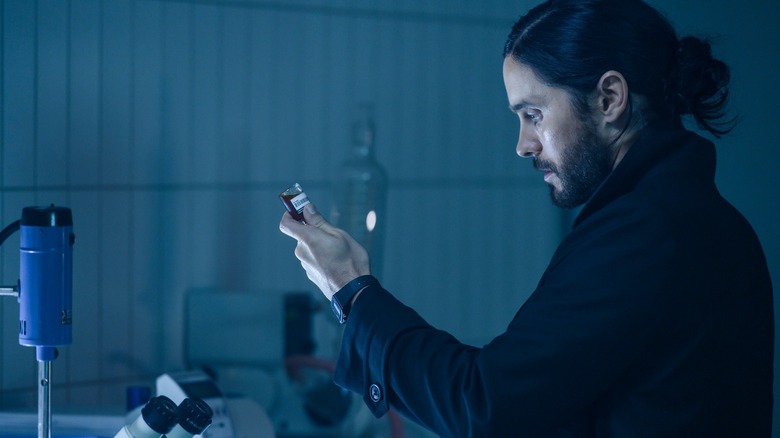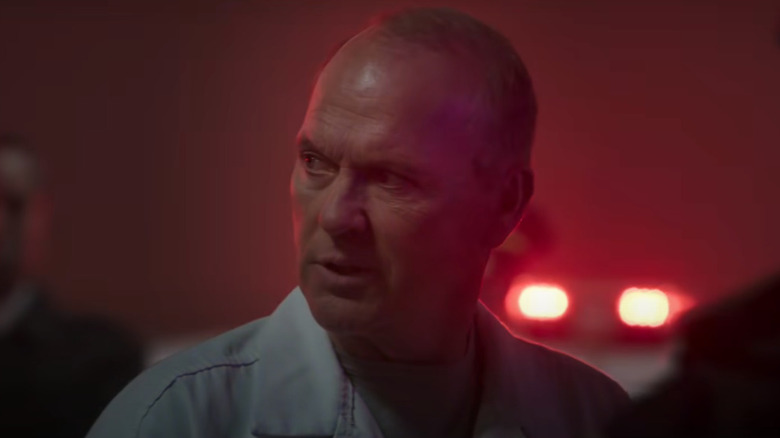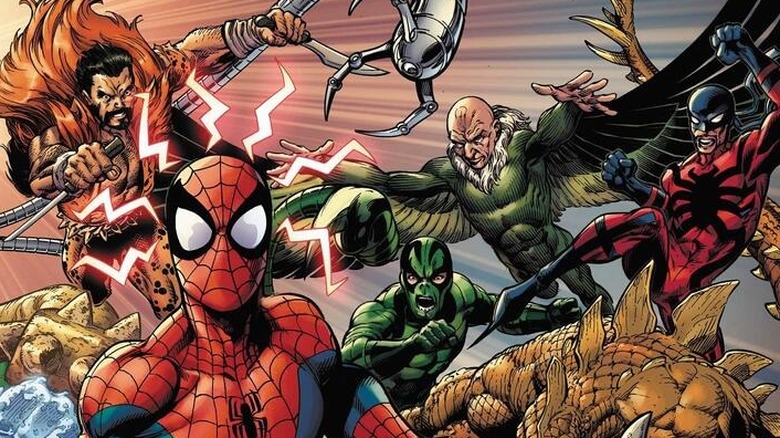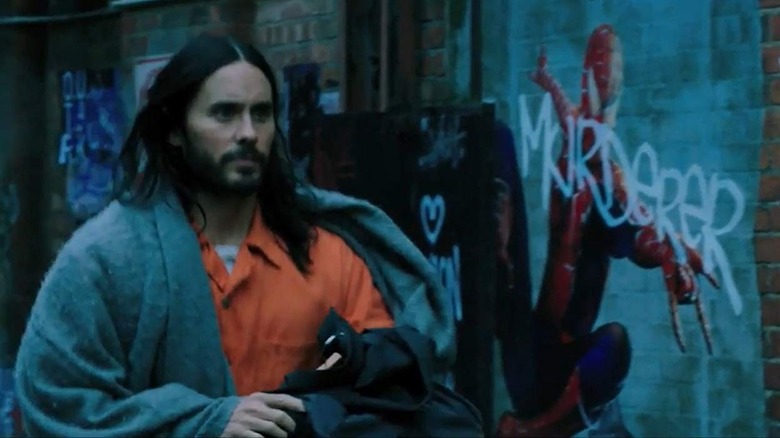The Morbius End Credits Scenes Raise A Ton Of Confusing Questions
"Morbius," the latest Marvel Comics adaptation from Sony Pictures based on one of the many characters within the "Spider-Man" franchise they control, was originally supposed to come out in July of 2020. For obvious reasons, that didn't happen. However, the movie has finally arrived and, like virtually any big franchise film these days, it contains a post-credits scene (technically two) that help to tee up the ball for some things that might come our way in the future. Unfortunately, in this case, these end credits stingers are truly baffling in many ways and raise a ton of questions both within the universe that these movies take place in (dubbed Sony's Spider-Man Universe) as well as the choices made behind the scenes that led to the creation of these scenes in the first place.
Warning: massive spoilers ahead for "Morbius." Proceed with caution.
One thing I won't be doing here is doing a hugely detailed breakdown of the post-credits scenes as we already did that elsewhere. But it is incredibly important to acknowledge that even the movie's director Daniel Espinosa has confirmed that the scenes as we see them in the final product were not part of the original plan and things changed in large part due to "Spider-Man: No Way Home," which had some huge ripple effects on the Marvel multiverse. Speaking with us, Espinosa explained:
"The way that he arrives had to be changed after Spider-Man, because it showed you how he arrived. So, that was worked on, that Michael Keaton was going to meet Morbius. That was the fundamental idea that they always had."
We'll dive more into this in a moment but the reasoning kind of falls apart pretty quickly when we consider that this movie was originally supposed to come out nearly two years ago and Michael Keaton's Adrian Toomes was in the very first teaser trailer, and "No Way Home" hit theaters in December. A recipe for messiness is what we have here.
The Vulture arrives in the Venom-verse
The key logic problem here is that Keaton was always part of the equation. As I have gone over in detail previously, a metric ton of stuff from the trailers did not make the final theatrical cut of "Morbius," including virtually every bit of footage of Keaton that we had seen ahead of the release. It is pretty clear that the notion of how the multiverse works in "No Way Home" further impacted a great deal of editing this movie underwent over the last year and change, with some pretty crappy looking CGI mirroring the cracked sky of the multiverse being stitched onto the first post-credits scene attached to "Morbius," which clearly transports Toomes from the Marvel Cinematic Universe into the same universe occupied by Tom Hardy's Venom and Jared Leto's Dr. Michael Morbius.
In the original trailers, while the logic was not explained, we didn't know about this crack in the multiverse brought on by Doctor Strange, but we did have the concept of multiversal variants around, with J.K Simmons playing a different version of J Jonah Jameson in "Spider-Man: Far From Home," technically reprising his role from the original "Spider-Man" trilogy, but clearly as a different iteration of the character. To me, it always looked like this was how they were going to explain Keaton appearing in the Venom-verse. He was just another version of the character within the larger multiverse. Now? The whole thing is pretty screwy.
First of all, Toomes being transported from the MCU doesn't make a great deal of sense as those who knew that Peter Parker was Spider-Man were being transported to that universe, not away from it. Second of all, now Toomes is away from the MCU. What happened to his family? Is he not concerned about them at all? Because the scenes as they play out certainly don't make it seem as though he is, and his entire motivation for becoming Vulture in "Spider-Man: Homecoming" essentially hinged on providing for his family. A weird flex at best. Not to mention that there is a huge issue if the MCU ever wanted Keaton to return as Vulture now, as they would have to bring him back from this other universe. The notion of a variant would have been far less complicated for all involved.
The not-so Sinister Six
In the second post-credits scene (which really just feels like the second half of the same post-credits scene), Vulture in his full-on Vulture costume meets Morbius out in the middle of nowhere to discuss some things. We already have some questions because Toomes did not have his costume when he was transported to this universe, so where did he get this one? He didn't have any abandoned alien technology to build it with, and the Tinkerer wasn't there to help him build it, so where did it come from? Quite honestly, this was probably done so Keaton didn't have to be on set and could just provide the voice against some CGI but the fact remains it creates yet another big unanswered question.
Even more confusing are a couple of big things hinted at in this scene. For one, this is clearly trying to set up the Sinister Six, something that Sony has been trying to make happen dating all the way back to "The Amazing Spider-Man 2." Yet, rather confusingly, Vulture suggests to Morbius that they could "do some good." That is wildly confusing as the Sinister Six in the pages of Marvel Comics only band together with the goal of ending Spider-Man. Period. There is no good in them. They are not "The Suicide Squad," and even if Marvel/Sony wanted to go that route, Marvel Comics has "Thunderbolts," which more closely mirrors "The Suicide Squad." So this is another weird thing to throw in there.
Lastly, and perhaps most importantly, Spider-Man is directly acknowledged by name in this scene. That means the same universe that "Morbius" and "Venom" take place in has a Spider-Man, but it's not clear which Spider-Man it is. Is it Tobey Maguire? Is it Andrew Garfield? We don't know! We get no help from the actual movie because Spidey isn't even referenced and we have no reason to believe that Leto's Morbius ever encountered the webslinger. And with that graffiti of Spider-Man from the trailers removed from the theatrical cut, this was an odd thing to throw in willy nilly just like this. It is all confusing and it's hard to trace the logic of all of it beyond Sony wanting a Spider-Man in this universe — but there has to be a better way.
What does all of this even mean?
So what does all of this add up to? What does all of this even mean? Is Keaton going to team up with Leto, Hardy, and maybe Aaron Taylor-Johson's Kraven the Hunter (among others) for an eventual "Sinister Six" movie? Is the idea that one of these future movies within Sony's Spider-Man Universe will formally introduce us to the version of Spidey that exists in this universe? Is Sony just using the multiverse to do as they please while Tom Holland's Spider-Man is tied up in the MCU? There is no question Sony wants to do some big world-building here but the way that was handled within "Morbius" is messy no matter how you look at it, and it absolutely reeks of putting the cart before the horse.
I get it. After the wild success of "Venom," Sony had every reason to think that making franchises out of Spider-Man villains and connecting those films together wasn't a bad idea but they seem to be getting ahead of themselves and that is creating problems. Perhaps the same problems that Warner Bros. created in trying to play catch up to Marvel by making "Batman v Superman: Dawn of Justice" instead of something more akin to "Man of Steel 2." Perhaps the same problems that cropped up after the release of "The Amazing Spider-Man 2" where an Aunt May solo movie was on the table for god's sake. At the very least, for the moment, these end credits teases leave us with lots of questions that may well have unsatisfying answers in the end.



